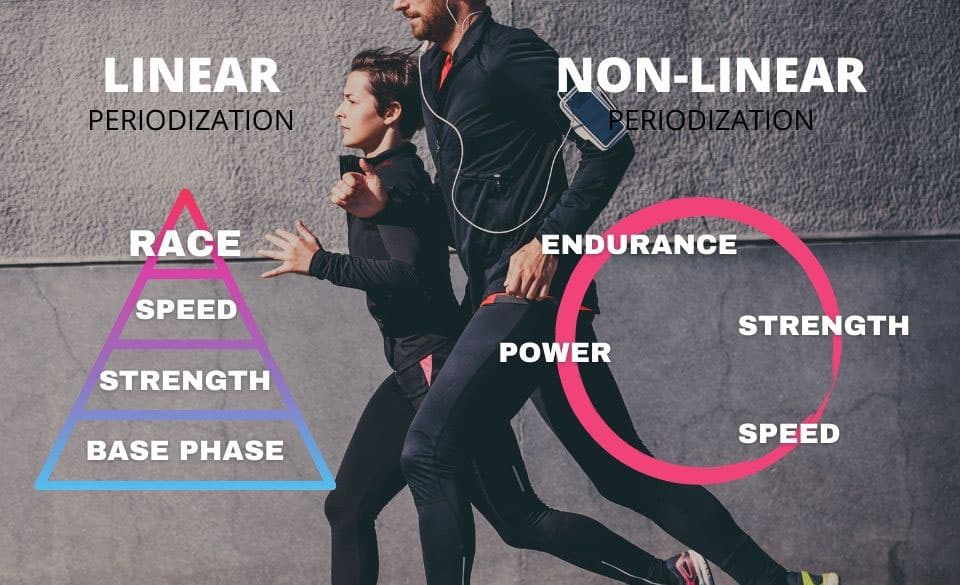
Marathon Periodization Program – UPDATED 2021 – A Complete Guide
Page Contents
A good marathon periodization program progresses you through phases to optimally prepare you for the marathon. When you are training for a marathon, you can’t maintain peak shape all year round.
Periodozation works on the principle of overload and adaption, and there are three types of cycles you need to know.
– A macrocycle which is your season as a whole and can be constantly changed.
– A mesocycle, which is a dedicated training block (ie: endurance phase).
– A microcycle which is a dedicated training block, which lasts no more than one week.
In this article, we discuss the different cycles and the different periodization methods for marathon running.
Marathon Periodization Program – A Complete Guide
The first major periodization plan for runners was developed by New Zealand coach Arthur Lydiard in the late 1950s. This linear periodization is still used today by runners around the world. But as running has gotten more scientific and runners have become faster, new marathon periodization training plans have adapted.
Periodization refers to the build-up of training phases that produce a performance peak at the end of that sequence or phase. Before periodization came along, runners tended to primarily base their training on increasing overall workload. While this is still somewhat true today, we now divide the training cycle into distinct phases.
When building a marathon periodization program there are two types of periodization, linear and non-linear that the program can be built around.

A linear periodization (Lydiard-style periodization) involves starting the training cycle with a base phase. This is where runners increase their volume of easy to moderate paced running. The base phase is then followed by a strength phase where you start to incorporate hill running and other strength work into the mileage.
Once the strength phase is finished, you can then move into the racing phase. This is where the volume and intensity is reduced, and short intervals and tune-up races are incorporated to promote recovery and fitness.
A linear periodization is what most runners know today still. But many coaches now believe that the sudden introduction into the race phase after mostly low-intensity running carries a risk of injury. This is where non-linear periodization comes in.
A non-linear periodization plan mixes these phases throughout the training cycle to minimize injury risk. This means strength and interval training is continued throughout the plan, thus helping the muscles and joints adapt to the stress of harder running. Because of these runners are more likely to race throughout the build-up, and they can peak for races quickly with some added race-pace training. There is no waiting for the next phase of the program if your race hungry.

Mesocycle Marathon Training
Mesocycle marathon training represents a specific block or phase of training. For example, during the build phase of your training, you may design a mesocycle to enhance muscular endurance (hill repeats). This mesocycle might consist of two sessions a week for the next 3 weeks, focusing on hill repeats or similar.
Similarly, you might develop a mesocycle during one of the later stages of your periodization. This could be to help build your threshold pace through tempo runs or intervals and may last for three weeks.
There are many ways to incorporate mesocycles into your training plan. They typically range from three to four weeks in length and the most common mesocycle period is a 21 or 28-day training block.
Adding a shorter 21-day mesocycle to your training is the wiser choice if you have not experienced this before. If you have started with a 28-day mesocycle and find you are constantly fatigued, go back and use the shorter mesocycle.
Macrocycles, Mesocycles, Microcycles
Building the right marathon periodization program is the right way to promote increased training effect. To develop an effective marathon training plan, it is important to understand the foundation behind periodization.
The foundation behind periodization consists of cycles. These cycles are called macrocycles, mesocycles, and microcycles.
Macrocycles
The macrocycle is the longest of the three cycles and takes your whole season into account. This means that all stages of a linear periodization program are included and incorporates all 52 weeks of your annual training plan. Because of its length, you can make changes throughout the year.
Mesocycles
As spoken previously in this article, a mesocycle is designed to provide a specific block of training into your plan. This block typically lasts 21 or 28-days or around three to four weeks.
Microcycles
The shortest of the three is the microcycle, this cycle typically lasts around a week. During this week, the goal is to facilitate a specific block of training. For example, a marathon runner may string together two or three long runs together within one week. Another example is when the runner incorporates two or three consecutive days of hard workouts, followed by an equal amount of recovery days.
Adding microcycles into your training plan can help improve key physiological abilities such as aerobic capacity or lactate threshold. If you are doing multiple microcycles tied together, this then becomes a mesocycle.

Strength Training Periodization For Runners
Just like your running, strength training must be structured in a way to help you improve and stay injury-free throughout your training plan. Many runners think that periodization is only valid for running, but this is not the case. Setting up the correct strength training periodization for runners is vital in making improvements in your strength and mobility.
When building a strength periodization plan for runners it is important to break the training into three phases.
Build Phase
The first phase of the strength training program should focus on the basic ability to lift weights. This gives you an introduction to lifting correctly and provides some injury resilience, while also building consistency.
– General Strength
– Introduction to movement
– Injury resilience
– Consistency
Much like your running periodization, the base training phase introduces you to lifting and then helps you build a foundation for later in the program.
Competition Phase
The second phase of your strength periodization plan requires more speed and specific weightlifting. Since you have been working on injury prevention and general strength in the base phase, it is now time to focus more on:
– Speed
– Coordination
– Fast-twitch response
So during this phase, the focus should be on explosiveness and power. We accomplish this by adding more weight and introducing specific explosive lifts.
Peak Phase
The last phase when planning strength training periodization for runners is the peaking phase.
This phase helps you prepare your form to be at its best. By improving your running efficiency and increasing your power and force production, you are creating a peak in fitness ready for your event.
– Improve running economy
– Increased Rest
– Power and force
During this phase of training, you would include more plyometrics and Olympic lifts. This will help improve the reactive forces of your muscles and tendons.
During this period your total workload will increase and then taper off as your race approaches.


Download Running the Mile for only 8usd
“A Know-all Short Report All About Long Distance Running”



